 |
||
|
||
| ||
The NAS technology (network attached storage) is not a new in the market. Traditional methods of solving a problem of shortage of disc space (extension of a capacity of a server's disc subsystem or a purchase of a new server) are concerned with particular difficulties. First, you should disable a server for some time, and secondly, it's necessary to adjust it what should be done by professional administrators. The NAS technology was developed as an alternative to universal servers carrying a lot of functions (printing, applications, fax server, e-mail etc.). NAS servers implement only one function - a file server function, thus fulfilling it better, simpler and faster. Main advantages of the NAS:
At the end of 1999 Quantum company, one of the top hard disc manufacturers, introduced their NAS solutions. Today the Quantum Snap! Server family consists of three models:
(*) depends on hard discs used, in this year the maximum size is planned to grow twice. Common features for all models:
In this review we will deal with the 2000 and 4100 models. Snap! 2000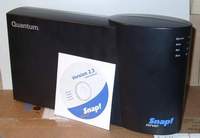 The Quantum Snap! Server 2000 is supplied with:
The best advantage of the NAS devices is easy installation and setup. Let's see whether the Quantum Snap! 2000 proves it. So, let's try a "quick start". First we connect a power supply cable, a network cable and turn on.... One and a half minute later a WORKGROUP and one computer in it called SNAP46842 appeared in the network environment. There we have found a common folder Share1 which could be worked with right away! Of course, the device was started at default, and a proper setup (names of share folders, protocols, security) may take more time; however, the developers have done everything to minimize an initial turn-on: you needn't to adjust the hardware or start some programs. The server, however, has only two buttons - power and reset.  Now let's take a closer look at the device. On the rear panel there are two connectors - power and network RJ-45, as well as a power switch and a reset button. The latter one is used to nullify some server settings if it can't be accessed via a network. On the front panel there are four indicators:
On the whole, the Snap! Server is a specialized computer designed to fulfill file server functions. Officially, Quantum doesn't say what OS is installed here, but some signs indicate one of the Unix versions. Server control and setup can be accomplished by two ways: using a Snap! Assist program from a local memory and from a Web-browser (as well as via the Internet). First, let's consider the first program. 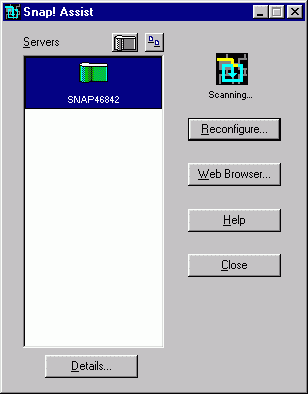 Started, the Snap! Assist is looking for all connected Snap! servers in a LAN. For each server there is some short info on its configuration: 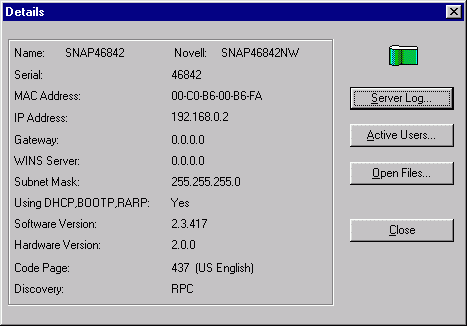 If you know an administrator's password, then a program will let you configure a server. The first item is "Server Settings". Here you can
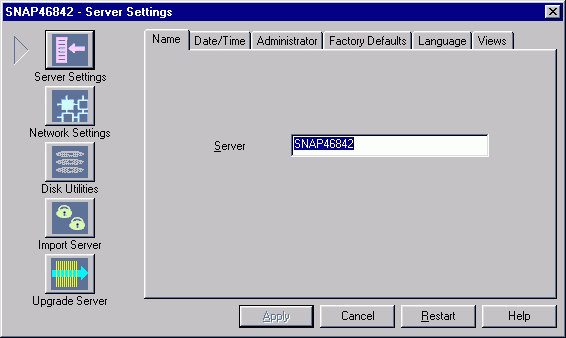 I should note that starting from MS-DOS operating systems of Microsoft letters for file names can be used only from one, current language. It means that you couldn't have files with names in English, German, French etc. on one computer. But since such situations were rare nobody tried to solve it. Now, when PCs are starting to join in networks, the problem has become stronger. And now in Windows 2000 which supports Unicode both in files and in network protocols the problem seems to be solved soon. So, now the Snap! server supports all letters in file names when working with clients under Windwos 2000. The second item is "Network Settings" where a network part of a Snap! server configuration is adjusted. Note that all information on a server can be retrieved via a Web browser. It allows to create a simple Web server on a Snap! base (of course without Perl, ASP, SSI, CGI etc.). File recording to a server via a Web is not supported. 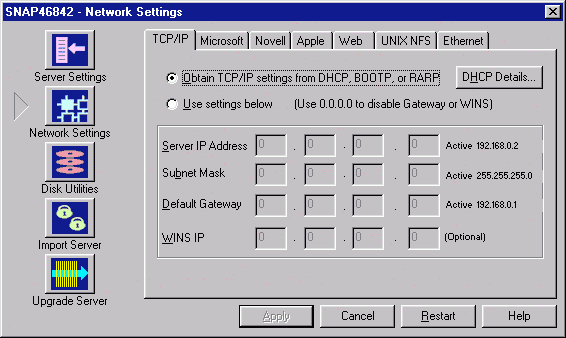 A setup of a disc subsystem is implemented in the "Disk Utilities". Here you can set a disc configuration - mirror (RAID 1), stripe (RAID 0) or just two separate discs (JBOD), check and format a disc(s). 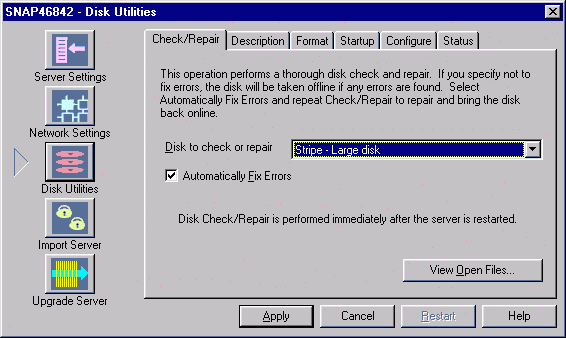 To simplify installation of a new Snap! server or replacement of an old one the manufacturer included a function of importing settings from one server to another: 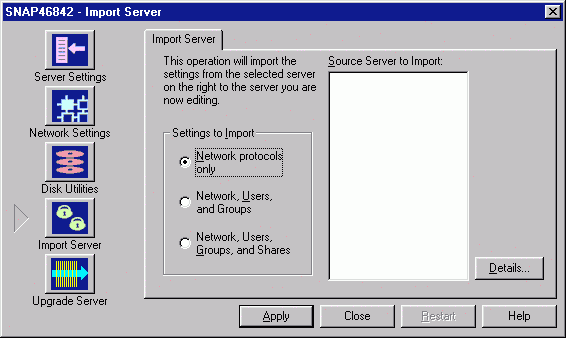 The last item is "Upgrade Server" which allows to load a new version of an internal software. 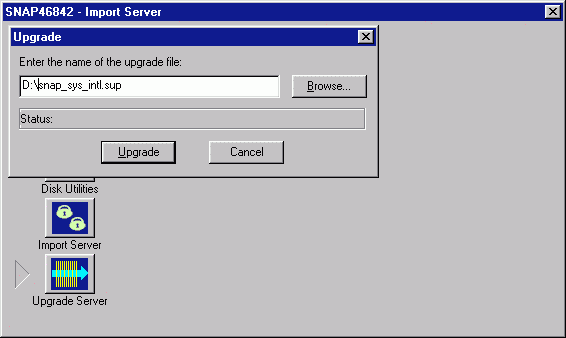 If some system settings of the server are changed the server reloads automatically. It takes the Snap! 2000 one and a half minute. Another way to setup is by using a Web browser. You can establish shared folders and access rights only by this way. The first page of the server is generated automatically or can be established by a user:  As I have already said, you can retrieve any information on the server via Web (considering the access rights). A page with a server configuration can be found here: http://ServerIP/config. In order to access it you have to key in an administrator's password. 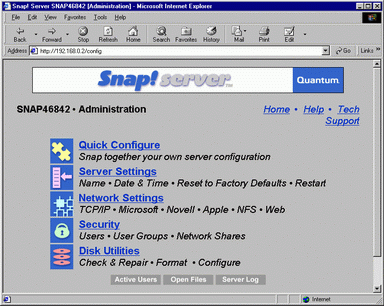 New items, as compared with Snap! Assist, include "Quick Configure" and "Security". The first one will allow you to setup the server quickly, having answered only few questions. The second one, "Security", is used to setup shared folders, users, groups and access rights. You can connect the Snap! server an already working system based on Windows NT Server or NetWare. A list of users for the Snap! in this case is taken from an installed NT or NetWare server. Note that first of all a name is checked according to a local base, and only after that the server is accessed. 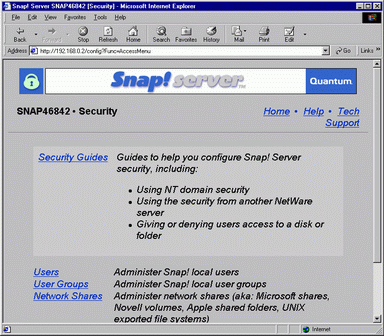 In peer-to-peer network you can use integrated means of Snap! server access restriction. You can establish users, combine them into groups. For each created shared folder you can create a list of users and groups who have an access to it. Like in many other systems there are three access levels - full, read only and no access. 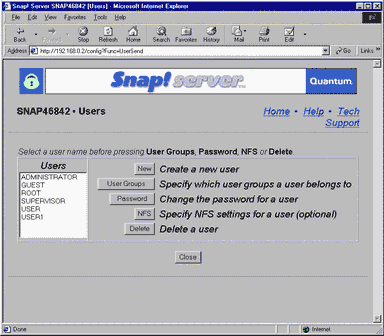 Note one more interesting possibility of Snap! servers. Working within the Microsoft NT Server network, the Snap! supports Microsoft's DFS technology (Distributed File System). It allows to add some extra space for files to a shared volume to the NT server at several minutes! You needn't even reboot the server, and clients keep on working: their requests are resent to the Snap! server. After installation and setup we measured the server's
operating speed. The discs are set into RAID 0 mode. For comparison
we have taken a PC with Windows NT Server 4.0 and one SCSI disc.
A usual computer with Windows 98 was a client. For testing we used
a program for reading files from a network disc and measuring speed
of this process. The results are:
As you can see, a speed of the Snap! is similar to that of a simple server under Windows NT. PowerQuest DataKeeper 4.1 Snap EditionThe server includes a backup copying program PowerQuest DataKeeper 4.1: 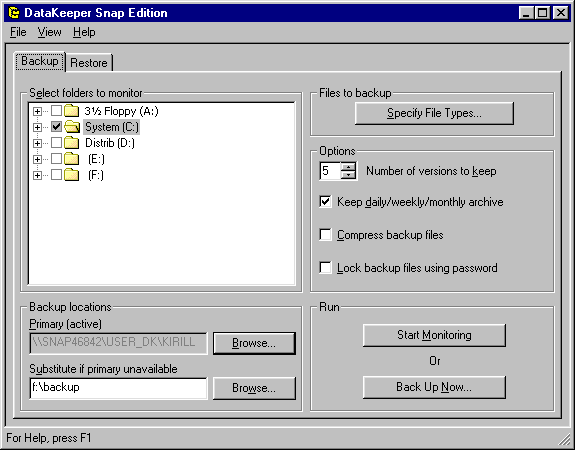 The program allows to make backup copying from working PCs to the Snap! server. There is a mode of non-stop operation for tracing new files and their automatic saving. Several copies can be stored at the same time, so you can return not only to the last copy. A backup from each PC where a user is working is also stored. The program worked very interestingly. In default settings there is a filter for exe, com, dll and some other files. That is why having done a backup copy and then have recovered a couple of directories I lost some exe files, and this backup copying didn't make any sense. I lost the whole directory only because there were two exe and two bat files. Besides, it turned out that DRV, Program Files and Win98 directories weren't transferred to a backup copy from disc C. So well, the program is not that bad, but I recommend to change default settings. Snap! 4100 Now we are going to dive into the layout of the Snap! Server 4100. The 4100's complete set:
On the front panel there is a power switch and indicators: "Disk" (one for each disc), and "System", "Link", "Net" and "Disk". Besides, there is a hole of a reset button. On the rear panel there are power and network connectors. The model we have has four 27 GBytes discs. They can be used in different configurations:
Besides, if there is a free disc, you can configure it as reserve to be used if a disc in a mirror or in RAID 5 is out of order. Totally you can get 110 GBytes for an array with interleaving or 83 GBytes for RAID 5. And again, like in case of the Snap! Server 2000, a hot replacement of discs is not supported. On the other hand, a disc access is much more convenient, and they can be easily replaced even by not a specialist. By the way, the device is not exacting to a trademark of the hard discs: I tried to install an old Fujitsu 3.5 GBytes and the Snap! accepted it easily. Configuration is identical to the Snap! 2000, the difference lies only in a choice of possible disc modes - RAID 5 has been added. The Snap! 4100 spends about two minutes for rebooting. The Snap! 4100 will help us to study an internal architecture of the Snap!. servers (you can view pictures in more details) Inside the case there is a minicomputer board, 4 hard discs and a power unit: 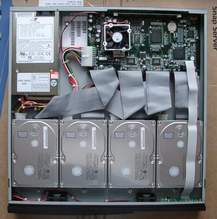 The board uses Intel Pentium MMX (we failed to set a frequency since a heatsink was glued right to a socket), Intel 430TX chipset, 64 MBytes SDRAM DIMM, a network controller based on the Intel 82559, RAID controller on two Promise PDC20265 chips (every disc uses its own channel): 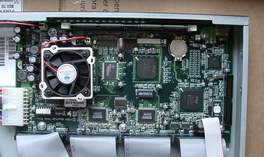 The discs installed are Quantum Fireball Plus LM. Their characteristics:
A power supply unit is normal for 1U devices of ATX standard. The device is cooled by 4 fans - in a power supply unit, on the processor (automatically controlled depending on a temperature) and two more are located on the front panel. Since the discs heat much I would recommend to install the Snap! 4100 only in a case with proper ventilation. The read speed was:
The Snap! server is far ahead, especially in case of small files. Furthermore, we used ZDLabs NetBench program as another test. Of course, results of a test with only one client are not demonstrative, but they can be used to estimate the overall performance. 4 models were used in the test:
For comparison we have taken a PC with Microsoft Windows NT Server 4.40 SP6 and IDE (IBM DTLA 15 GBytes) and SCSI (Quantum Atlas 10k II 18GBytes) discs. 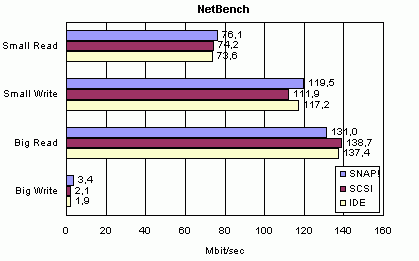 As you can see the server again outshines others. For the picture be be complete here are data of NAS devices' performance studying by eTesting Labs: 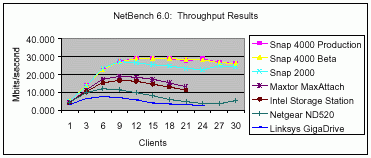 Not so long ago a new (3.0) software version has been released with such new possibilities as:
Note that starting from this version of the software server control and setup is accomplished only via a Web browser, and the Snap! Assist program is used only to change an administrator's password and to upgrade internal software. Ultimately, there are two illustrations of new possibilities of the software: establishment of ACL for files and directories and setting of disk quotas: 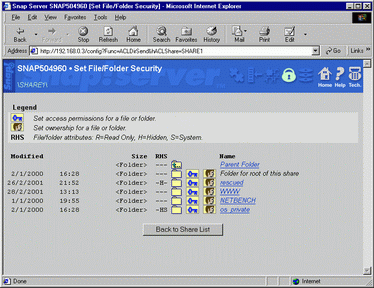 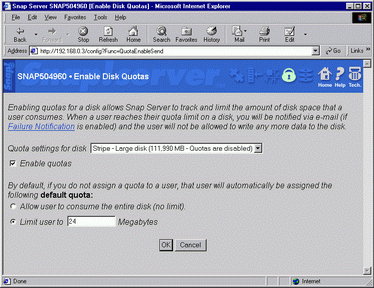 ResumeThe Quantum Snap! servers showed excellent functional
possibilities and simplicity in handling. Plus, Quantum Snap!, as
compared with Compaq, Dell and HP solutions have cheaper price tags.
According to Quantum, today 80% of NAS solutions are Snap! servers.
I hope that after amalgamation with Maxtor, Snap
Appliances, as a separate company, will continue to produce
such convenient and fact NAS devices. Write a comment below. No registration needed!
|
Platform · Video · Multimedia · Mobile · Other || About us & Privacy policy · Twitter · Facebook Copyright © Byrds Research & Publishing, Ltd., 1997–2011. All rights reserved. |